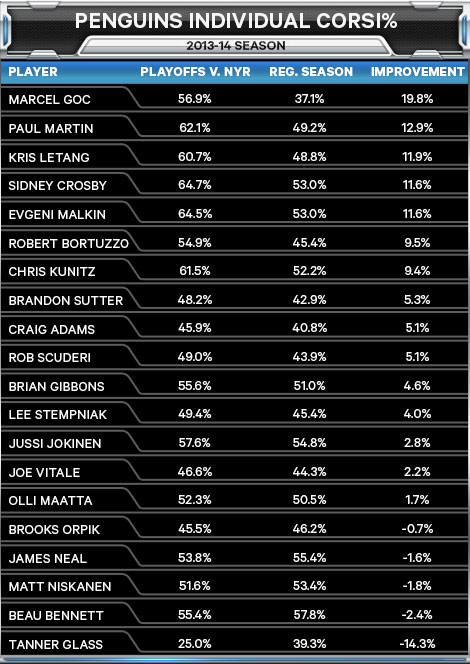Entering the playoffs, the New York Rangers were a pretty popular sleeper choice among people who pay attention to numbers to make it to the Stanley Cup final. The Rangers posted a 53.2 percent Corsi% with the score close at 5-on-5 this year, the second-best number of any playoff team in the Eastern Conference. Their PDO (shooting percentage + save percentage) in those situations was 98.7, worst of any East playoff squad.
This tells us the Rangers did a good job of controlling play when the score was close this year, generating a higher share of shot attempts than all but one of the East’s top eight teams, but were abysmal at turning that advantage into goals-for and preventing goals against. One of the things that the numbers guys have learned over the years is that an edge in Corsi% tends to persist and that PDO problems (or success) tend to not.
The most notorious example of this is the 2011-12 Los Angeles Kings, who had a Corsi% with the score close of 54.9 percent and a PDO of 99.7. When they got into the playoffs—as an eight seed—the Kings started to get some more bounces that, combined with their strength in controlling play, led to them becoming the first No. 8 seed to win the Stanley Cup. It also led to countless managers of mediocre teams thinking that they have a real shot at a Cup if they can just eke into the playoffs—but that’s a story for a different day.
The thinking with the Rangers was along the same lines as it was for the Kings. Their regular season probably understated how good they actually were because of some rotten puck luck. Through one round, the theory looked good—the Rangers played pretty well and knocked off a Flyers team that many thought would move past them.
The second round has, however, been a disaster for New York. Two things catch the eye when looking over the stats: The Rangers haven’t put up the possession numbers that one would expect against the Penguins and their power play has been terrible. The awfulness of the Rangers on the man advanatge has been beaten into the ground, so we’ll focus on the 5-on-5 play.
Pittsburgh is a team that was seen as a bit of a paper tiger by a lot of numbers guys heading into the playoffs because they were into their second year of abysmal possession numbers when Sidney Crosby or Evgeni Malkin weren’t on the ice.

Over the past two seasons, Pittsburgh games have almost been two contests in one. When Crosby or Malkin are on the ice, the Penguins outscore the other team at 5-on-5 by a lot. When they’re not, the Penguins are as bad as the worst teams in the NHL. From that perspective, a Pittsburgh game over the past two seasons has been a weird sort of Frankenstein affair, in which the half of the team that produces like the NHL elite tries to drag the horrible half of the team to victory.
That was true in Round 1 against the Columbus Blue Jackets—the Pens controlled play when Sid or Geno were on the ice and did poorly when they weren’t. They managed to overcome it and win. This round, Pittsburgh’s getting great possession numbers from their entire lineup, with nearly everyone besting their regular season numbers.

Some of this improvement is easy to understand. Malkin and Crosby have a lengthy history of playing better together than apart—not surprising given that they’re two of the five best players in the world or so. They’ve played together much more than usual in this series and done well. The flip side of that is that James Neal hasn’t been riding shotgun for Malkin. He’s one of the few Penguins whose numbers have been worse in this series than they were in the regular season.
We knew going into this series that Pittsburgh was going to win the portion of the game when Crosby and Malkin were on the ice. It’s the superior numbers put up in the playoffs versus the regular season by some of Pittsburgh’s depth players that are really mystifying. If the Rangers were going to compete in this series, they were going to do it by taking advantage of Pittsburgh’s lack of depth. They haven’t been able to.
Why has this happened? There are two explanations that seem most likely. First, the Penguins are finally healthy after a tough season and have gelled at the right time. I’m skeptical that this is true. Their problems with depth extend back to last season. What seems more likely to me is that the Rangers are just in a tough spot in the schedule in terms of games played. Pittsburgh wrapped up their first round series April 28, the Rangers didn’t finish their series until April 30.
What made finishing on April 30 even worse was that the Rangers played the night before. So Game 1 in Pittsburgh was their third game in four nights. After a day off, they played back-to-back games again. Game 3 was the Penguins third contest in seven days. It was New York’s fifth.
It didn’t have to be this way. The Rangers-Flyers first round series had a pair of two-day breaks, presumably to meet the needs of American television and those of the always-busy Madison Square Garden. Had that series proceeded on a more sensible timeline, the Rangers wouldn’t have had to play a pair of back-to-back games to end the series.
If Pittsburgh moves on and their depth players produce awful results in the next round, the Rangers will have a legitimate grievance that they were cheated somewhat by the schedule maker. Of course, a better power play might have been able to overcome a bad schedule—and that’s not on anyone but them.


